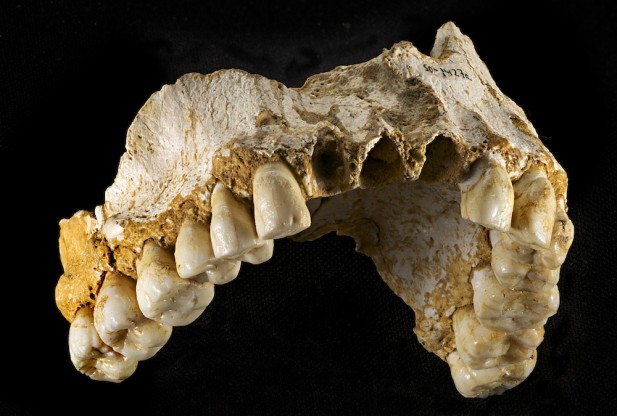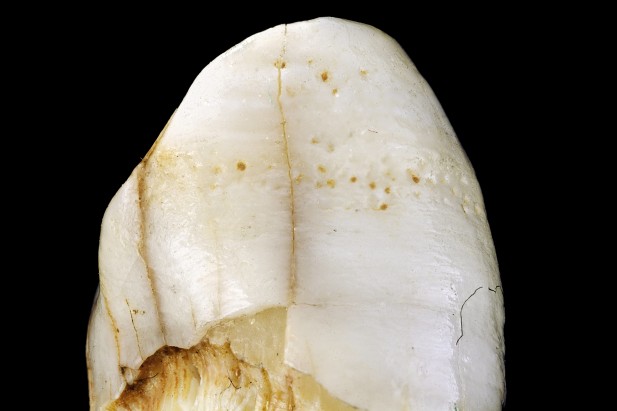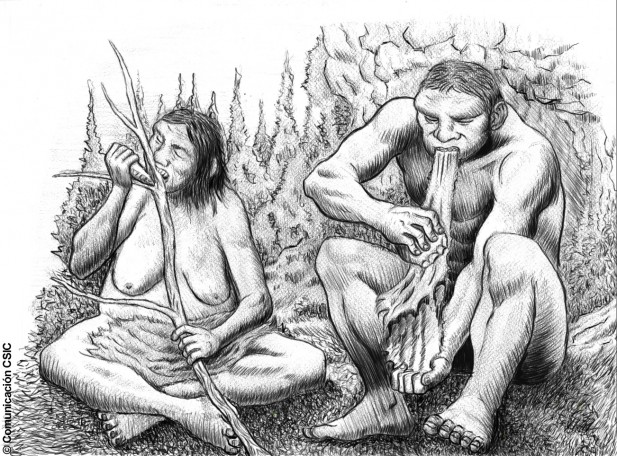
© Joan Costa/Spanish National Research Council (CSIC)Neanderthal jaw bone.
A new study examining Neanderthal teeth from Western Europe suggests that there was a division of labor between males and females. The study was conducted by members of the Department of Paleobiology at the Spanish Museo Nacional de Ciencias Naturales and published online this month in the
Journal of Human Evolution.
Although Neanderthals were once thought to be
less intelligent,
adaptable, and
creative than modern humans, recent studies have significantly changed the understanding of our Ice Age cousins.
We now know that Neanderthals had the capability for complex speech, controlled fire, created a variety of sophisticated bone and stone tools, wore clothing, decorated their bodies with shells and pigment, and may have created art. In addition, they were culturally and physically similar enough to the first modern humans in Europe that the two groups exchanged genetic material on multiple occasions beginning around 50,000 - 60,0000 years ago.

© Joan CostaNeanderthal tooth discovered in El Sidron cave.
Several recent discoveries relating to Neanderthal
health,
diet, and
maturation have been made through the examination of fossilized teeth. The new study by Almudena Estalrrich and Antonio Rosas builds on that research by using differences in tooth wear to suggest that Neanderthal males and females engaged in separate activities. While division of labor between the sexes is documented among modern and historic
hunter-gatherer societies, it has not previously been identified among Neanderthal populations.
Neanderthals exhibit
high instances of tooth wear on their incisors and premolars regardless of age or sex, suggesting that all Neanderthals regularly used their teeth as tools throughout their lifetimes. These patterns include chipping and fracturing of enamel, and striations created by using teeth as a "third hand," holding an object between the teeth and one hand while using a tool in the other hand to cut that item.

© Spanish National Research CouncilIllustration of Neanderthal division of labor.
Estalrrich and Rosas examined 99 incisors and canine teeth of 19 separate Neanderthal individuals from the cave sites of
El Sidron (Spain),
L'Hortus (France), and
Spy (Belgium). They discovered that striations on the teeth of adult Neanderthal women were consistently longer and more numerous than those found on adult men. Men exhibited more chipping and fracturing on their upper incisors and canines, while women had more chipping on their lower teeth.
Based on these different wear patterns, the investigators propose that Neanderthal men and women engaged in separate non-foraging tasks. Although it is not clear what specific activities caused the wear patterns, the authors suggest that women may have been responsible for the preparation of furs and garments.
According to Rosa, "The study of Neanderthals has provided numerous discoveries in recent years. We have moved from thinking of them as little evolved beings, to know that they took care of the sick persons, buried their deceased, ate seafood, and even had different physical features than expected ... So far, we thought that the sexual division of labor was typical of sapiens societies, but apparently that's not true."
Aaron Deter-Wolf is a Prehistoric Archaeologist for the Tennessee Division of Archaeology and an adjunct professor in the Department of Sociology and Anthropology at Middle Tennessee State University.You can follow his research at this website.
Reader Comments
to our Newsletter